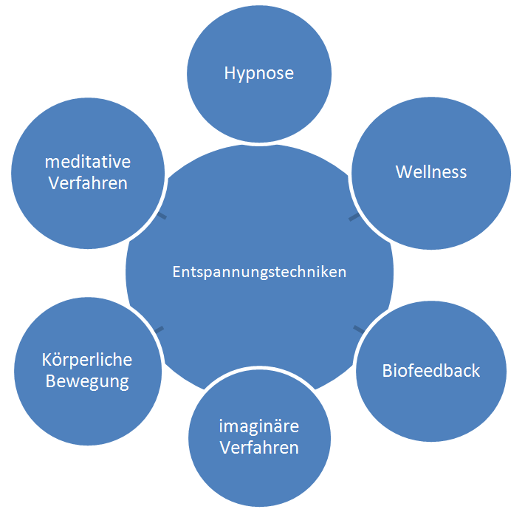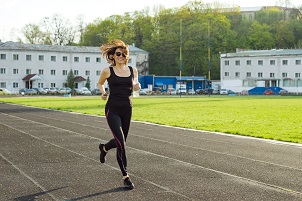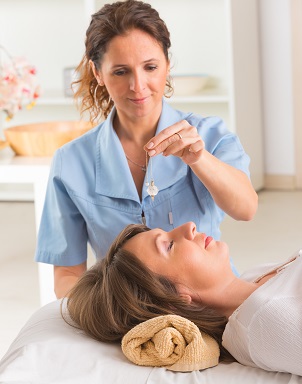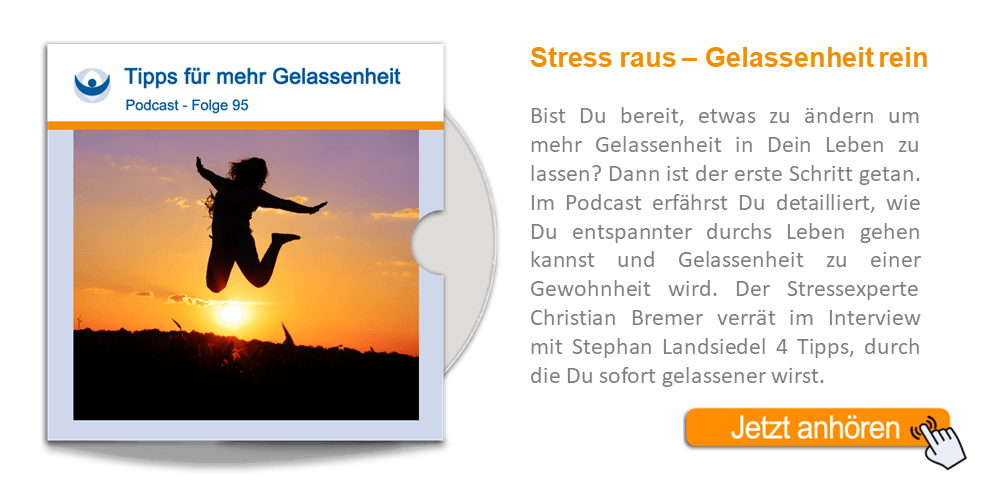Relaxation Techniques

When you type "relaxation techniques" into Google's search bar, the first suggested term is "relaxation techniques for stress." This makes perfect sense because when we're stressed, we naturally want to relax. Who hasn't experienced this? After a long, stressful day at work, you come home and just want to rest and lie down. But somehow, you can't seem to "wind down"! So the question arises: How can I relax now?
Table of Contents
- Introduction: What is Stress?
- General
- Classification of Relaxation Techniques
- Which Relaxation Technique is Best for Me?
Introduction: What is Stress?
To understand how relaxation techniques work, we first need to understand what stress means for the body. This content will be presented in abbreviated form here. For more information, please click here: Stress.
Stress is a completely natural reaction of the body to challenges. For our ancestors, having a certain level of stress was vital for survival. Because only through increased performance could they, for example, flee from wild animals or defend themselves. When we are stressed, certain stress hormones such as adrenaline, dopamine, and cortisol are released in the body. These stress hormones ensure that energy reserves are released and that we are capable of higher performance, more focused work, or faster and more effective reactions. Like most hormones, stress hormones are broken down more quickly through movement. From an evolutionary perspective, this context makes sense, as a Stone Age human needed more energy only in a flight situation and could break it down again by running away, for example. Today, many people have the problem that they experience stress not only in life-threatening situations but also constantly at school, at work, or at home. In this form of permanent stress, it is called "chronic stress."
With chronic stress, it can be easily imagined that the body is constantly required to work at peak performance. Due to the persistent effect, physical reserves are depleted, and negative effects can occur in somatic, psychological, and affective areas.
Somatically or physically, this can mean for the patient:
- increased blood pressure
- increased heart rate
- digestive & metabolic disorders
- skin problems
- tension
- sleep disorders
Psychologically, chronic stress can lead to...
- depression
- burnout
- eating disorders
- etc.
Emotionally, this means for the person…
- inner restlessness
- pain
- fear
- nervousness
General
For the human body, it is enormously important to alternate between periods of tension and relaxation. To prevent or directly reduce stress, various techniques can be applied. These techniques are generally referred to as relaxation techniques.
By applying relaxation techniques, one can physically...
- lower breathing and heart rate
- lower blood pressure
- reduce muscle tension
- strengthen the immune system
Affectionately and psychologically, relaxation techniques also have a positive impact on our bodies, such as...
- inner peace
- balance
- serenity
- enhanced creativity
- better memory retention and recall
- less susceptibility to noise disruptions
- quicker problem-solving abilities
Classification of Relaxation Techniques
Relaxation techniques can generally be divided into 6 major groups:

- Physical Movement
- Meditative Techniques
- Hypnosis
- Imaginary Techniques
- Biofeedback
- Wellness
Physical Movement

Physical movement encompasses all relaxation techniques involving sports, endurance, or exertion. Increased movement stimulates metabolism, causing stress hormones like cortisol to be broken down faster, resulting in decreased stress levels. Techniques of physical movement can be further distinguished into rhythmic movements, such as endurance sports like walking, hiking, jogging, or swimming; exertion methods such as spinning or squash; and other physical methods, including dancing, sex, masturbation, or cycling.
Meditative Techniques

The primary goal of meditative techniques is to distance oneself from one's own thoughts. This is often achieved through the practice of mindfulness exercises or concentration exercises. During a mindfulness exercise, one focuses attention on a specific object, image, melody, or one's own breath and follows it. A very well-known mindfulness exercise would be observing one's own breath.
Instructions ~ Observation of One's Own Breathing Technique
The purpose of this exercise is to consciously perceive and feel the automatic process of breathing.
Close your eyes, regardless of your current position, and place one of your hands on your stomach. Breathe deeply in through your nose and out through your mouth. Perceive and feel your breathing very clearly and consciously. Imagine when inhaling that you are absorbing all the energy from the air and when exhaling, expelling all the bad from yourself. Breathe completely relaxed and naturally. Observe your breathing. How many seconds do you inhale? How long do you exhale? How long do you pause between inhaling and exhaling? Now, change your position once. Go from sitting to lying down or from lying down to standing. Feel your breath very clearly again. What do you notice? Has your breathing changed compared to the other position? Can you perhaps identify a specific breathing technique within yourself?
In addition to traditional meditation, meditative techniques also include relaxation methods such as Yoga or Qigong.

Yoga originated in India but is now practiced worldwide. Traditional Indian yoga is closely associated with Hinduism and is therefore considered a spiritual union of the self. When people refer to yoga in Western culture today, they usually mean modern, body-focused yoga, also known as "Hatha Yoga." A particularly well-known exercise of modern yoga is the Downward Facing Dog.
If you have no prior experience with yoga, it is advisable to start by attending a yoga class to get started. Yoga classes are available in almost every larger city. However, yoga can also be learned easily from YouTube videos or DVDs. However, receiving yoga exercises explained solely through auditory means is not suitable for beginners. Generally, modern Western Hatha Yoga is seen as an enriching form contributing to personal development. Finally, it is important to mention that nobody can perform the exercises of Hatha Yoga perfectly from the beginning, so do not be discouraged if many others in your yoga class seem more flexible or perform applications better - because practice makes perfect, as the saying goes.
Hypnosis

When most people think of hypnosis, they immediately imagine a magician who suddenly puts someone into a trance and makes them behave like a chicken. This form of hypnosis is also called rapid or instant hypnosis and is only found in show business. However, hypnosis is also used in psychotherapy for treating addiction disorders, depression, or stress reduction. Originally, hypnosis was believed to be a sleep-like state. However, this thesis has been refuted in recent years by measuring brainwaves. Today, hypnosis is technically referred to as a "state of deep relaxation with wakeful consciousness." Hypnosis is often used to induce trance states. Hypnosis is generally divided into auto- or self-hypnosis (which includes Autogenic Training) and hetero-/heterohypnosis.
There are various methods to induce a trance state through hypnosis. These methods are divided into direct and indirect methods. Direct methods include classic hypnotizing with a pendulum, where the focus is always directed to an object, and a trance state is achieved through a combination of monotony and suggestions. In contrast, indirect methods work exclusively with suggestions. However, these are formulated very vaguely, as in the Milton model, so that the person being hypnotized can fill in the placeholders given in the text themselves. An example of this would be "Imagine biting into your favorite fruit."
Autogenic Training is a form of self-hypnosis technique. It was developed and published by Johannes Heinrich Schulz in 1931 and is still widely used in psychotherapy. Unlike many other relaxation techniques, Autogenic Training must be learned. This can be done through courses or using DVDs & CDs. However, a course variant is recommended in this case, as most people need 5-7 weeks even with a course to fully master Autogenic Training. The goal of Autogenic Training is to be able to induce a state of relaxation solely through self-influencing words (Autosuggestions). Autogenic Training is learned in various steps, and in a professional training, it is practiced three times a day for about 5-7 weeks. To try it out, it is best to watch a video and initially attempt to approach autosuggestion through heterosuggestion.
Instructions
Get into a comfortable position for you. And say internally
"I am completely calm." "I am completely calm." ...(x7)
"My arms are very heavy." (x7)
"My arms are very heavy and warm." (x7)
"My breathing is calm and steady." (x7)
"My stomach is pleasantly warm." (x7)
"My forehead is pleasantly cool." (x7)
Imaginary Methods

The most well-known representatives of imaginary methods are fantasy journeys. Fantasy journeys are used both as a simple relaxation technique and in psychotherapy. They serve to find new strength and to create a personal safe space. In a fantasy journey, it is important first to create a relaxed atmosphere, often achieved through essential oils or background music. The second step is a short relaxation phase. This relaxation phase is followed by the actual fantasy journey. The participant is told a fictional story. The story leaves plenty of room for free associations and is told with pauses of 30 seconds to two minutes, allowing the participant enough time to immerse themselves completely in their own world. After about 30 minutes, the participant is brought back to reality through deep breathing. The final step involves a discussion about the experience, or the journey is reflected upon in a creative form such as painting.
Biofeedback
Relaxation techniques using biofeedback involve observing one's own bodily functions. Breathing techniques, for example, are very well known. If you concentrate on your breath for a long time, you will eventually notice that you always make a slightly longer pause between exhaling and inhaling, which you didn't perceive before.
Also counted among biofeedback approaches is the Progressive Muscle Relaxation developed by Edmund Jacobson. In this relaxation form, specific muscle groups are alternately tensed and then relaxed voluntarily. The focus is on the transition from tension to relaxation. It always starts with the feet, then gradually moves through the individual muscle groups up to the neck and fingers. The goal is to be able to induce this form of muscular relaxation whenever the client wants. Progressive Muscle Relaxation can also help to detect and release tension. The easiest way to learn this relaxation technique is through a CD, a video, or by reading specialized literature.
Wellness

Wellness is not classified as a classic relaxation technique but can still make a significant contribution to stress management. The focus here is on taking real time for oneself and doing things that one enjoys or that make one feel comfortable, good, and relaxed. Many people go to a spa or sauna for this purpose. However, wellness can also be found in the home bathtub, engrossed in a good book, or solving a puzzle like a crossword puzzle while being able to switch off.
Which relaxation method is optimal for me?
Relaxation methods are generally procedures that are intended to reduce physical and mental tension. This goal can be achieved through ritualized settings with a fixed duration, posture, and focus on an idea or sensation. It is important to practice relaxation techniques frequently, repetitively, and more often so that the state can stabilize. The more frequently, longer, and more often you practice, the easier it becomes to activate these methods gradually in everyday life.
For beginners, it is advisable to initially focus on only one specific technique and later learn more techniques. Advanced practitioners should be familiar with and able to use several relaxation techniques because the greater the selection, the more likely you are to find the right method for yourself. Which method is really the right one for you you simply have to find out by trying. There is no test or classification for this. The only important thing is that you feel comfortable with the method in the situation.
Many people also use different techniques in different situations. For example, many people use autogenic training to fall asleep, progressive muscle relaxation is offered during breaks in some schools, and some employers finance yoga courses. It's best to look around in your environment and open yourself up to the new relaxation possibilities you've just discovered.
